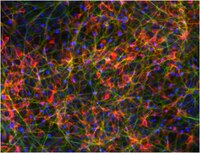GF041 Sigma-AldrichMonocyte Chemotactic Protein-1, Recombinant rat
The Macrophage/monocyte chemoattractant protein-1 (or MCP-1 protein) plays an important role in the inflammatory response of blood monocytes & tissue macrophages.
More>> The Macrophage/monocyte chemoattractant protein-1 (or MCP-1 protein) plays an important role in the inflammatory response of blood monocytes & tissue macrophages. Less<<Recommended Products
Overview
| Replacement Information |
|---|
Key Specifications Table
| Key Applications | Species | Source | Purity |
|---|---|---|---|
| CULT | Rat | E.coli | Greater than 98% by SDS-PAGE analysis and HPLC analysis. |
| References |
|---|
| Product Information | |
|---|---|
| Presentation | Lyophilized protein with no additives. The protein may appear as a haze or film which is difficult to see at the bottom of the vial. |
| Quality Level | MQ100 |
| Physicochemical Information |
|---|
| Dimensions |
|---|
| Materials Information |
|---|
| Toxicological Information |
|---|
| Safety Information according to GHS |
|---|
| Safety Information |
|---|
| Packaging Information | |
|---|---|
| Material Size | 10 µg |
| Transport Information |
|---|
| Supplemental Information |
|---|
| Specifications |
|---|
| Global Trade Item Number | |
|---|---|
| Catalog Number | GTIN |
| GF041 | 04053252678448 |
Documentation
Monocyte Chemotactic Protein-1, Recombinant rat SDS
| Title |
|---|
Monocyte Chemotactic Protein-1, Recombinant rat Certificates of Analysis
| Title | Lot Number |
|---|---|
| RECOMBINANT RAT MCP-1 | 2981093 |
| RECOMBINANT RAT MCP-1 - 2424614 | 2424614 |
| RECOMBINANT RAT MCP-1 - 2193267 | 2193267 |
| RECOMBINANT RAT MCP-1 - 3607089 | 3607089 |
| RECOMBINANT RAT MCP-1 - 3889488 | 3889488 |
| RECOMBINANT RAT MCP-1 - 3952360 | 3952360 |
| RECOMBINANT RAT MCP-1 -2707829 | 2707829 |








